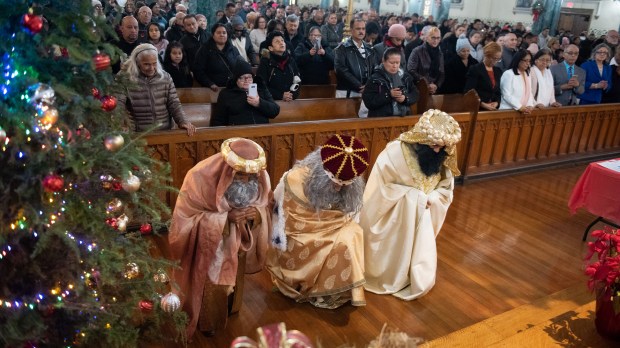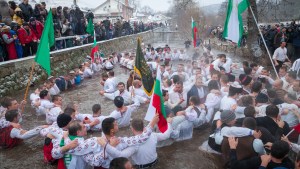If we meditate on the mystery of the Mass, we come to see how the mystery of the Epiphany that we celebrate this Sunday mirrors the Mass. The liturgy is not only a celebration of the mystery of the Epiphany — it is the mystery of the Epiphany in act.
A star and a procession
The event of the Epiphany begins with a miraculous star shining in the heavens and beckoning the magi to follow. They see in its light a hope, a radiant promise, the flickering of a new beginning. When we go to Mass, one of the first things that we notice in church is that the candles on the altar are lit (as is also the vigil light near the tabernacle). The lighted candles are a sign of a godly event soon to transpire in the sanctuary. They signal the something wondrous that is about to take place in this place: heaven uniting with earth in the event of the Sacrament of the Altar, drawing us all into the divine Presence.
The first liturgical action of the Mass — the procession — in a way resembles the last moments of the magi’s long journey: their final approach to Emmanuel in the manger. Pope Benedict XVI referred to the journey of the magi as “just the beginning of a great procession that continues throughout history. With the magi, humanity’s pilgrimage to Jesus Christ begins.”
Penitential Act
Once they arrive in Jerusalem, the magi experience their own need, their own limitation. Their question to anyone who will listen is an appeal for mercy: Where is the newborn king of the Jews? We have come to do him homage. What we beg for in the Penitential Rite of the Mass is very much the same: “Show us, O Lord, your mercy. And grant us your salvation.”
Proclamation of the Word of God
When King Herod hears what the magi are asking for, he assembles the chief priests and the scribes, and inquires of them where the Christ is to be born. They respond by proclaiming Scripture:
And you, Bethlehem, land of Judah, are by no means least among the rulers of Judah; since from you shall come a ruler, who is to shepherd my people Israel.
God constantly reinvigorates our hope through the Word of God.
The presentation of the gifts
The magi come close to Christ’s manger, open their treasures, and offer Jesus gifts of gold, frankincense, and myrrh. More than anything, the gifts symbolize what the Newborn Savior will do for all people through the miracle of his Incarnation. Similarly, the gifts that we bring forward at Mass express our desire to serve Jesus the King (symbolized in the gift of gold), to worship Jesus the divine Son of God (symbolized in the gift of frankincense), and to unite ourselves in the suffering and death of our Redeemer who saves us by his cross and Resurrection (symbolized in the gift of myrrh).
Adoration
The Gospel account goes out of its way to give us this key detail: The Magi prostrated themselves and did him homage. Why? As the Catechism teaches:
No one, whether shepherd or wise man, can approach God here below except by kneeling before the manger at Bethlehem and adoring him hidden in the weakness of a new-born child (563).
We do so at every Mass. Before we receive the Eucharist in Holy Communion, we kneel down and we adore: in the Elevation of the Host, and in the invitation, “Behold the Lamb of God, behold him him who takes away the sins of the world.”
Holy Communion
The magi instantly begin to live a communion made possible only through the coming in the flesh of the Son of God. It is symbolized in the way they find the Christ Child: On entering the house, the Magi saw the child with Mary his Mother. Mary, Model of the Church, embodies the communion we are destined to share and become even as she cradles in her arms the Body of Christ. “Mary is the Mother of the Life from whom all people take life” (Bl. Guerric of Igny).
Departing by another way
The magi departed for their country by another way. They opt, not just for a new route but, for a new way of living. The miracle we experience in the Mass calls us to the same. The priest or deacon dismisses us saying, “Go in peace, glorifying the Lord by your life.”
Pope Benedict XVI reflected that the post-Bethlehem magi became “constellations of God that mark out the path.” In their witness was released “an explosion of light, through which God’s radiance shines upon our world and shows us the path.” He adds that the saints, too, “are God’s true constellations which light up the nights of this world, serving as our guides. Dear friends, this holds true for us too.”


